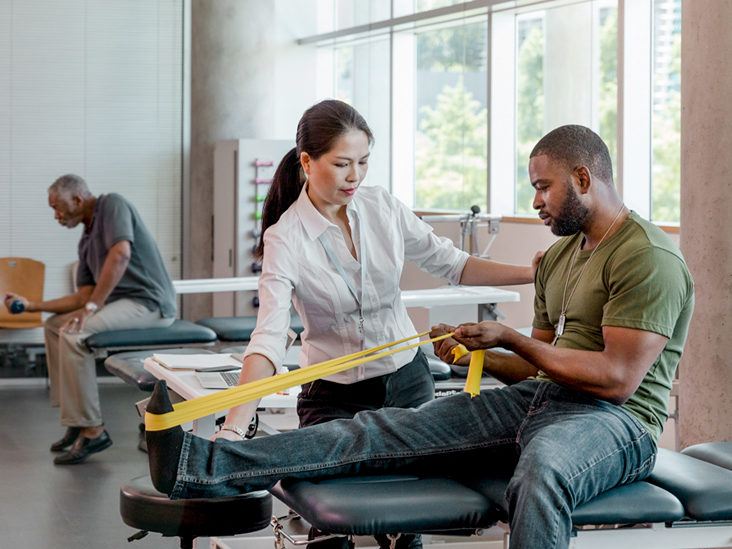If you are experiencing pain or have been injured, your doctor may recommend physical therapy. This is a great way to heal your body and get back to your normal routine. Physical therapy involves a variety of tests and treatments that are designed to help you regain strength and mobility. In this blog post, we will discuss the different types of physical therapy tests that you may encounter during your treatment. We will also provide tips for preparing for these tests and recovering from them successfully!
Contents
- 1 What Is Physical Therapy Test?
- 1.1 What Are The Examples Of Physical Therapy Tests?
- 1.2 Active Range of Motion (AROM)
- 1.3 Manual Muscle Testing (MMT)
- 1.4 Joint Mobilization
- 1.5 Balance Testing
- 1.6 Gait Analysis
- 1.7 Agility T-Test
- 1.8 Adam’s forward bend test
- 1.9 Crossover step test
- 1.10 Flamingo test
- 1.11 Hop test
- 1.12 I-Y-T test
- 1.13 Kneeling lunge test
- 1.14 Left-leg-raise test
- 2 What Is the Purpose of the Physical Therapy Test?
- 3 What Are the Types of Physical Therapy Tests?
- 4 What Happens During Physical Therapy Testing?
- 5 Conclusion
What Is Physical Therapy Test?

A physical therapy test is a diagnostic procedure used to determine the cause of pain or dysfunction. It may be performed by a physical therapist, chiropractor, orthopedist, or other healthcare providers. The test may involve taking a medical history, performing a physical examination, and ordering imaging tests such as X-rays, MRI, or CT scans.
What Are The Examples Of Physical Therapy Tests?
The examples of Physical therapy tests are as follows:
Active Range of Motion (AROM)
This test is done to find the range of motion of a joint. The therapist will move the joint through its full range of motion and document the results.
Manual Muscle Testing (MMT)
This test is used to check the strength of specific muscles. The therapist will apply resistance to the muscle while the patient tries to move the limb. The results are then documented.
Joint Mobilization
This test is used to assess the mobility of a joint. The therapist will move the joint in different directions and document the results.
Balance Testing
This test is used to assess a patient’s ability to maintain their balance. The therapist will have the patient stand on one leg or walk in a straight line. The results are then documented.
Gait Analysis
This test is used to assess a patient’s gait (walking pattern). The therapist will observe the patient walking and document the results.
Agility T-Test
It is used to measure an athlete’s agility. The therapist will set up a course for the patient to run through and time them. The results are then documented.
Adam’s forward bend test
It is used to measure the flexibility of the spine. The patient will bend forward from the waist and the therapist will document the results.
Crossover step test
Used to measure an athlete’s agility. The patient will start in one corner of a square and then cross over to the opposite corner. The therapist will time the patient and document the results.
Flamingo test
Used to measure the flexibility of the hip. The patient will stand on one leg and bend the other leg behind them. The therapist will document the results.
Hop test
It is used to measure an athlete’s power. The patient will hop as far as they can and the therapist will measure the distance. The results are then documented.
I-Y-T test
The test is used to measure the flexibility of the spine. The patient will bend forward from the waist and touch their toes. The therapist will document the results.
Kneeling lunge test
It is used to measure the flexibility of the hip. The patient will kneel on one leg and lunge forward with the other leg. The therapist will document the results.
Left-leg-raise test
It is used to measure the flexibility of the hip. The patient will lie on their back and raise their or left leg straight up in the air. The therapist will document the results.
To assess a patient’s condition, these are just a few examples of physical therapy tests that may be used. Your therapist will choose the tests that are most appropriate for your case.
What Is the Purpose of the Physical Therapy Test?
The purpose of a physical therapy test is to find the source of pain or dysfunction so that appropriate treatment can be provided.
The purpose of physical therapy testing is to:
- Evaluate your condition
- Develop a treatment plan
- Monitor your progress
- Reassess your condition and modify your treatment plan as needed
What Are the Types of Physical Therapy Tests?

There are many types of physical therapy tests, but the most common are:
Medical history
The therapist will ask about your medical history, including any previous injuries or illnesses. For example, if you’ve had a back injury, the therapist will want to know how long ago it occurred and what kind of treatment you received.
Physical examination
The therapist will examine your body to look for signs of injury or dysfunction. This may include testing your range of motion, flexibility, and strength. For example, the therapist may ask you to lift your leg or arm to see how well you can move it.
Functional assessment
The therapist will assess how well you can perform everyday activities, such as walking, climbing stairs, or getting in and out of a car. This helps them to understand the extent of your injury or dysfunction.
Laboratory tests
In some cases, the therapist may order blood or imaging tests to rule out other conditions or to get more information about your condition. For instance, blood tests can show whether you have inflammation, which is often associated with conditions such as arthritis. Imaging tests such as X-rays, MRIs, and CT scans can provide more information about the structure and function of your joints, muscles, and nervous system.
Functional capacity evaluation (FCE)
An FCE is a series of tests that measure your ability to perform activities of daily living, such as lifting, carrying, and walking. The therapist uses the results of the FCE to develop a treatment plan that is tailored to your individual needs.
Isokinetic testing
Isokinetic testing is used to assess your muscle strength and function. The therapist attaches sensors to your skin that measure the electrical activity of your muscles as you move your joints through a range of motion.
Manual muscle testing
Manual muscle testing is used to assess your muscle strength. The therapist applies pressure to your muscles as you attempt to resist the force.
Maximal voluntary contraction
A maximal voluntary contraction is a test of your muscle strength. The therapist applies pressure to your muscles as you attempt to generate the greatest amount of force possible.
What Happens During Physical Therapy Testing?
During physical therapy testing, your physical therapist will ask you to perform a variety of tasks and movements. These may include simple tasks such as walking or standing, or more complex movements such as squatting or stepping up onto a stool. Your therapist will use these tasks to assess your strength, flexibility, balance, and coordination.
Your therapist will also ask you about your symptoms, how your injury is impacting your daily life, and what your goals are for physical therapy. This information will help them create a personalized treatment plan that meets your specific needs.
Conclusion
It may be concluded that physical therapy tests are important to assess the patient’s condition and progress. The tests also help physical therapists to create an appropriate treatment plan. In addition, physical therapy tests can help prevent injuries by detecting problems early on. Finally, these therapy tests can be used to monitor the effects of treatments and to evaluate the need for changes in the treatment plan.
Physical Therapy help patients recover from pain. If you’re experiencing Back pain, Shoulder pain, Knee pain, Neck pain, Elbow pain, Hip pain, or Arthritis pain, a physical therapist at MantraCare can help: Book a physiotherapy session.


